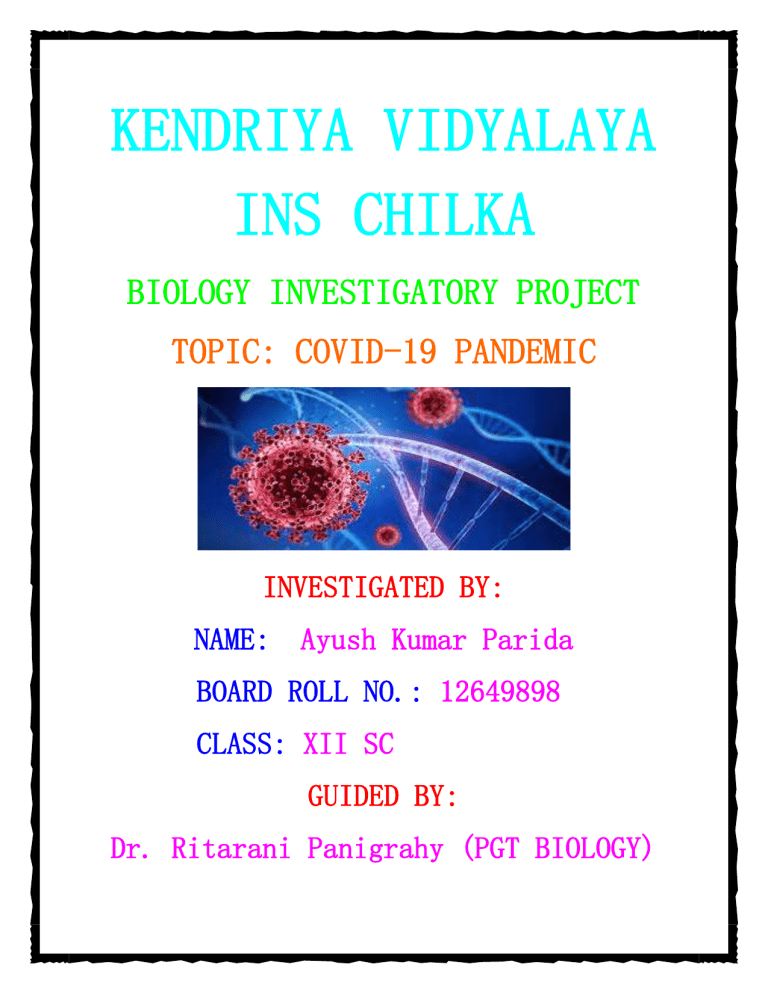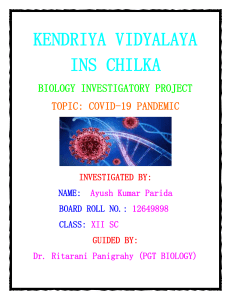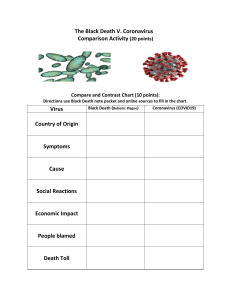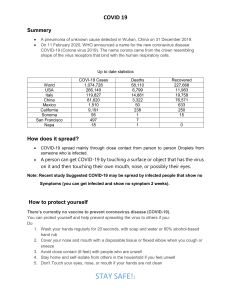
KENDRIYA VIDYALAYA INS CHILKA BIOLOGY INVESTIGATORY PROJECT TOPIC: COVID-19 PANDEMIC INVESTIGATED BY: NAME: Ayush Kumar Parida BOARD ROLL NO.: 12649898 CLASS: XII SC GUIDED BY: Dr. Ritarani Panigrahy (PGT BIOLOGY) CERTIFICATE This is to certify that this Biology Investigatory Project on the topic COVID-19 Pandemic has been successfully completed by Ayush Kumar Parida of class XII Science under the guidance of Dr. Ritarani Panigrahy in partial fulfillment of the curriculum of Central Board of Secondary Education (CBSE) leading to the award of annual examination of the year 2021-22. Sign of External Sign of Internal Sign of Principal Sign of Student ACKNOWLEDGEMENT I would like to convey my sincere gratitude of almighty god. It is my utmost pleasure to express deep sense of gratitude towards Dr. Ritarani Panigrahy my Biology teacher, who directed me to complete this project successfully. Her valuable guidance, support and supervision are considerably responsible for bringing this project attain its project form. I also wish to acknowledge my heartfelt thanks to my principal Sri. Dibakara Bhoi for providing all the facility required to complete this project. A special thanks to my parent for giving encouragement, enthusiasm and invaluable assistance to me. Without all this, I might not be able to complete this project. And Thanks to my dear friends who helped me to complete this project in time. INDEX 1. 2. 3. 4. 5. 6. 7. 8. 9. 10. 11. 12. Certificate Acknowledgement Introduction to COVID-19 History: Infection of corona viruses How it spreads Incubation period Diagnosis Symptoms Treatments Prevention Facts about COVID-19 Bibliography INTRODUCTION TO COVID-19 Hosts, Reservoirs and Infected Animals Infect birds and mammals Bats are hosts to the largest number of viral genotypes of coronavirus Epidemics can occur when viruses transmit from one species to another Can cause mutations in proteins that allow viruses to bind to cells Humans Human coronaviruses are causes of respiratory and gastrointestinal tract infections Estimated to account for 5-10 percent of all adult upper respiratory tract infections (“common cold” to pneumonia and ARDS) GI symptoms including diarrhea When mutations occur, coronaviruses can be a significant cause of human epidemics HISTORY: INFECTION OF CORONA VIRUSES Coronaviruses: History of Infections Severe Acute Respiratory Syndrome (SARS)2002/2003 Guangdong Province of China Beta coronavirus Transmitted from bats to civets to humans Began in February 2003 and outbreak lasted until July 2003 More than 8000 total cases, 774 deaths, fatality rate of ~9.6% Middle East Respiratory Syndrome (MERS) – 2012 Saudi Arabia Beta coronavirus Transmitted from camels to humans More than 2400 cases, 858 deaths, fatality rate of ~34.4% HOW IT SPREADS Droplets or aerosols: When an infected person coughs, sneezes, or talks, droplets or tiny particles called aerosols carry the virus into the air from their nose or mouth. Anyone who is within 6 feet of that person can breathe it into their lungs. Fecal-oral: Studies also suggest that virus particles can be found in infected people’s poop. But experts aren’t sure whether the infection can spread through contact with an infected person’s stool. If that person uses the bathroom and doesn’t wash their hands, they could infect things and people that they touch. Airborne transmission: Research shows that the virus can live in the air for up to 3 hours. It can get into your lungs if someone who has it breathes out and you breathe that air in. Experts are divided on how often the viruses’ spreads through the airborne route and how much it contributes to the pandemic. Surface transmission: Another way to catch the new coronavirus is when you touch surfaces that someone who has virus has coughed or sneezed on. You may touch a countertop or doorknob that’s contaminated and then touch your nose, mouth, or eyes. The virus can live on surfaces like plastic and stainless steel for 2 to 3 days. To stop it, clean and disinfect all counters, knobs, and other surfaces you and your family touch several times a day. INCUBATION PERIOD The incubation period of COVID-19, which is the time between exposure to the virus and symptom onset, is on average 5-6 days, but can be as long as 14 days. Thus, quarantine should be in place for 14 days from the last exposure to a confirmed DIAGNOSTIC TESTS Antibody (Serology) Tests What they do: These tests detect antibodies that signal that the body has mounted an immune response to the virus. They do not indicate whether a person has current COVID-19 infection, or when they were exposed. Method: Blood Sample Molecular Tests What they do: These tests loo for the virus’s genetic material and are the current standard for diagnosing COVID-19. Method: Nasal or throat swab, and for some test, saliva COVID-19 SYMPTOMS Fever or chills Cough Shortness of breath or difficulty in breathing Fatigue Muscle or body aches Headache New loss of taste or smell Sore throat Congestion or runny nose Nausea or vomiting Diarrhea TREATMENTS There is no specific, effective treatment or cure for corona viruses’ disease 2019 (COVID-19) the disease caused by the SARSCOVID-2 virus. But in India “Covishield” and “Covaxin” are used in this time. The “Oxford –AstraZeneca” vaccine has been approved for use in the UK. There is no vaccine approved by WHO. PREVENTION FACTS ABOUT COVID-19 BIBLIOGRAPHY With the help of: 1. Google https://www.webmd.com https://www.who.int https://www.narayanahealth.org 2. YouTube 3. Biology Teacher





